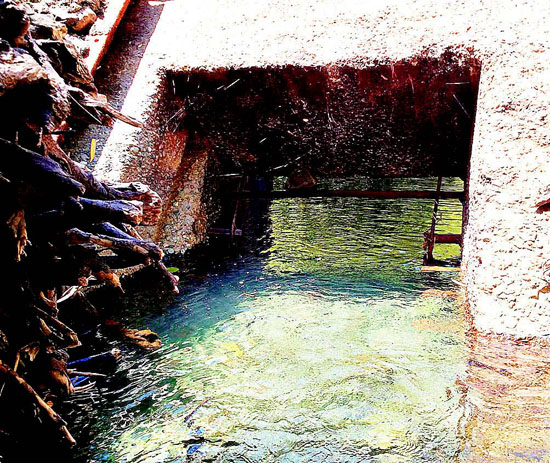
| ||||||
"I would say that the existence of trout has been gone for about 10 years, probably 20 years," said Reginald Barrett, a professor emeritus of wildlife management at UC Berkeley, who lives in Orinda. He now spends time doing as much for the creeks as possible. "We've been trying to change that trend for more than 10 years."
He laughs often at comments that he makes. "It takes having a sense of humor to be doing it as long as we have," he said, referring to appealing to the governmental organizations that provide municipal services to the area. That would include EBMUD, the California Department of Fish and Wildlife, the California State Water Control Board, and local authorities. He smiled at his friend Brian Waters, who is also on the board of FOC, as he said this. The two have been in the same fight for a decade, and even were roomies at Humbolt State back in the day. "We were roommates 56 years ago," said Waters, after laboriously climbing over a fence to get a current picture of the water barely trickling through the SB201-structure that is keeping rainbows from running up the creek. "But who's counting?"
Now they are united again in trying to get barriers removed, and to increase water quality, restoring standards to where they were before highway and major construction caused massive disruption in the landscape, and thus, to native trout populations.
Standing outside the library in downtown Orinda, Barrett pointed to the U.S. flag flying outside the Orinda city offices in front of the grand art deco building. "When I was in the fifth grade, that was my school, and I raised the flag on that flagpole," Barrett said about the city office complex that was once an elementary school. "When I looked out, there was none of this." He turned around to survey a strip mall, the highway, parking spaces, RiteAid, Safeway, and the hill below where a creek once ran openly through it. "There was a creek there, once," Barrett said. "And lots of fish. I know, because I saw them, all the time."
But now there is hope. Water quality has improved, and trout need clear water. They may yet be able to migrate back up into Upper San Pablo Creek, Waters and Barrett say.
Yet while trout populations are healthy along some East Bay creeks, trout have been largely absent since the construction of the highways and dam systems along the parts of San Pablo Creek to the south of the dam (the creek flows north), ever since the major construction of shopping areas and national and state highway systems were built. To complicate the issue, what the California Department of Fish and Game call "drop structures," or cement fortifications, were put in along creeks in the 1960s to, according to whom one talks, either impede water flow to decrease debris or to slow the water to keep it cleaner once it hits San Pablo Reservoir.
"The drop structure was put in place in the 1960s and its purpose is to prevent erosion of the creek onto EBMUD's aqueduct system and the erosion of the Bear Creek Road Bridge," said EBMUD public relations representative Nelsy Rodriguez via email. "EBMUD does on occasion clear the drop-off structure of debris, however it is not a regular practice."
Waters and Barrett have regularly tried for 10 years to get the drop structure, which has a grocery-cart sized opening in it, cleared so that trout can swim upstream.
San Pablo Dam was built circa 1960. Water flows down to it from San Pablo Creek originating in Orinda and flows north toward the bay. The San Pablo Dam holds up the water so that it can be stored and pumped and used otherwise, then the overflow drains again toward the bay. Trout still live in that part of the creek. But the upper part of the reservoir's source - the down-flowing part of San Pablo Creek - has the "drop structure" that keeps fish from going upstream again.
Roaches and sticklebacks are plentiful in the watershed upstream of the dam. But the trout have disappeared. "I think it's been at least 10 years since anyone has seen a trout," Barrett said. Chalk that up to 1960s construction, the paving over from highways, you name it. But the water quality is now such that a re-introduction of the fish makes sense, according to Waters and Barrett.
But fish can't get through a blocked "drop structure," which people from Friends of Orinda Creeks call a dam, so there is quite the literal impasse between the organization and its compatriots, all of whom would like to see the return of the native rainbows to their native homeland. The question is, when?


Reach the reporter at:
